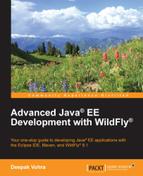WildFly is the new name for JBoss Application Server (JBoss AS) starting with version 8.0.0. WildFly provides high startup speed, low memory overhead, a high-performance, scalable web server, customizable runtime based on pluggable subsystems, and support for Java EE 7 and the latest web development standards. In past references to the server, "JBoss" is still used, but for subsequent references, "WildFly" is used. According to the Developer Productivity Report 2012, referred to subsequently as the "2012 report", JBoss is the most commonly used application server, with 28 percent of Java developers or organizations using the application server, more than any other application server. The same report indicated that 67 percent of Java developers use the Maven build tool, more than any other build tool. Eclipse is used by 68 percent of Java developers. The Java Tools and Technologies Landscape for 2014 report (referred to subsequently as the "2014 report") indicates that JBoss is the most commonly used application server in both development (16 percent) and production (17 percent). In the book, we discuss developing Java EE applications using WildFly 8.1.0, Maven 3, and Eclipse IDE. The book combines the most commonly used tools for Java EE development: WildFly, Maven, and Eclipse IDE.
The book is based on the Java EE standards 5, 6, and 7. We will discuss the commonly used technologies and frameworks JAX-RS 1.1, JSF 2.0, JPA 2.0, JAX-WS 2.2, EJB 3.0, Hibernate 4, Ajax, GWT 2.4, and Spring 3.1. The new Java EE7 support for JAX-RS 2.0 is discussed with RESTEasy. The new Java EE 7 feature for processing JSON is also discussed.
While several books on WildFly administration are available, none on Java EE application development with WildFly are available. WildFly is the most commonly used application server with support for all the commonly used Java EE technologies and frameworks. WildFly is efficient, lightweight, and modular, and provides a flexible deployment structure. JBoss Tools provides a set of plugins with support for WildFly, Maven, and Java EE frameworks such as JSF. Maven is the most commonly used build tool for compiling and packaging a Java EE application based on a project-object model (POM). Maven provides dependency management. The Eclipse IDE for Java EE developers is the most commonly used Java EE IDE.
The objective of the book is to discuss how a Java EE developer would develop applications with WildFly using Maven as the build tool and Eclipse IDE as the development environment. The book covers all aspects of application development, including the following topics:
- Setting the environment for an application
- Creating sample data
- Running a sample application
In Chapter 1, Getting Started with EJB 3.x, we discuss developing an EJB 3.0/JPA-based application with WildFly 8.1.0. According to the 2012 report, JPA (at 44 percent) and EJB 3.0 (at 23 percent) are the two most commonly used Java EE standards.
In Chapter 2, Developing Object/Relational Mapping with Hibernate 4, we discuss using Hibernate 4 with WildFly 8.1.0. According to the 2012 report, Hibernate (at 54 percent) is one of the most commonly used application frameworks. According to the 2014 report, Hibernate (at 67.5 percent) is the top object/relational mapping framework.
In Chapter 3, Developing JSF 2.x Facelets, we discuss using JSF 2.0 with WildFly 8.1.0. According to the 2012 report, JSF (at 23 percent) is the second most commonly used web framework. According to the 2014 report also, JSF is ranked second (at 21 percent) among "web frameworks in use".
In Chapter 4, Using Ajax, we discuss developing an Ajax application with WildFly 8.1.0. Ajax is a trend started in 2004-2005 that makes use of a web technique to transfer data between a browser and a server asynchronously.
In Chapter 5, Using GWT, we use Google Web Toolkit to develop an application with WildFly. According to both, the 2012 report and the 2014 report, GWT is one of the top four web frameworks.
In Chapter 6, Developing a JAX-WS 2.2 Web Service, we discuss developing an application based on the JAX-WS 2.2 standard in the Eclipse IDE using the Maven build tool. We deploy and run the application on WildFly 8.1.0.
In Chapter 7, Developing a JAX-RS 1.1 Web Service, we discuss developing a web service based on the JAX-RS 1.1 standard in the Eclipse IDE using Maven as the build tool. We deploy and run the application on WildFly 8.1.0.
In Chapter 8, Using Spring MVC 4.1, we discuss using Spring MVC with WildFly 8.1.0. According to the 2012 report, Spring MVC (at 30 percent) is the most commonly used web framework. In the 2014 report also, Spring MVC (at 40 percent) is the most commonly used web framework.
In Chapter 9, Using JAX-RS 2.0 in Java EE 7 with RESTEasy, we introduce the support for JAX-RS 2.0: the Java API for RESTful Web Services added to Java EE 7. We discuss the new Client API introduced in JAX-RS 2.0. We also discuss the asynchronous processing feature of JAX-RS 2.0.
In Chapter 10, Processing JSON with Java EE 7, we introduce another new feature in Java EE 7, that is, the support for JSR 353: Java API for JSON Processing.
